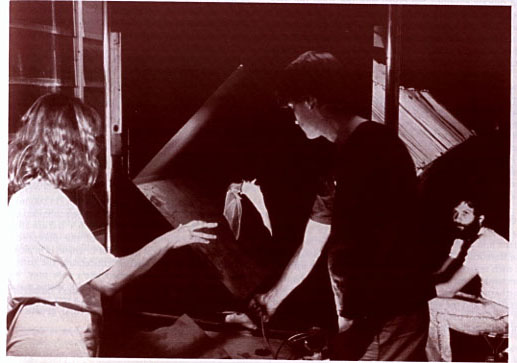1984 Appointed at PHYSIOLOGY
and PHARMACOLOGY to work for Prof. Jack Pettigrew funded by a
NHMRC grant. Designed and built sound sequencer and neural spike
logger, interface them to I.B.M. PC. The above was programmed in
assembler and the PC programmed in BASIC.
1985 Designed and built a
transient recorder, 4K ROM, 32K RAM 50KHz sample rate. Simulated
pre-trigger, programmed in assembler. Interfaced to I.B.M. PC,
the PC was programmed in Pascal. Designed and built Avi-phone
prototypes one and two. The latter using a 6511Q micro-processor
to implement digital delay lines.
1986 Built a NEC 7220 based
graphics display controller which was used to write a P.C.B. CAD
system for the apple 2 (written in Pascal). Built stepper motor
controller. Hoop position monitor. Digital sound generator for
generating stereo with good phase characteristics
1987 Ported CAD to IBM. Built
6511Q based Forth system use for all future 6511Q based
projects. Designed and built digital signal averager which uses
C.R.O. in X-Y mode to display menus, text and graphics. Sample
rates to 100KHz. This averager featured a nice user interface.
The averager was programmed in Forth and included major portions
of Forth assembler.
1988 Built an acoustic masking
analyser for psyco-physical hearing measurement. I designed and
built both electronics hardware for visually displaying reaction
times for vision touch and hearing. This was used for our
display for Univations at EXPO-88. I also made a system for
measuring micro-electrode impedance.
1989 Moved to new premises as
the Vision, Touch and Hearing centre was set up. Designed a
digital servo system using optical shaft encoders and a software
implementation of the servo loops. Shaft encoder output can be
up to 25KHz will servo routine running at 1KHz. The above system
was used to build a controller for the hoop in the anechoic room
and also to control a vestibular platform. I wrote a simulator
and Forth compiler for the RTX-2000 Forth engine.
1989 Wrote a cross-assembler ,
forth cross-compiler and native forth compiler for the
transputer.
1990 Photo-Refractor
controller,
|

Servo systems for a tunnel to
test how bats judge when to fold their wings to fly through an
opening. This was done by flying them through a 6 metre tunnel
which was fitted with infrared trip beams every 10 cm ( 56 beams
plus some tunnel without i.r.) to sense position and speed of
the bat. A transputer based card running my own forth compiler
was used to calculate the desired window position every
millisecond based on the bat's position and speed in order to
give the illusion that the end of the tunnel was closer than it
really was. The position commands were sent via the transputers
10 megabit/sec serial link to a servo system similar to the one
in the anechoic chamber.
I'm the one sitting down. Trish is the bat tosser and Ian is
holding a microphone. Photo by Jack Pettigrew.
There is a
paper on this --
Lee, D.N., van der Weel, F.R.,
Hitchcock, P., Matejowsky, E. and Pettigrew, J.D.(1993)
Common principles of guidance by echolocation and vision.
J. Comp. Physiol. A 171:563-572
|
1991 I'm currently working on
two main projects one using the transputer to generate complex
waveforms to play digital sound at 250 khz sample rate. This is
the first project that used GALS. The other involves testing
platypus electro-reception by digitizing the electrical
signatures of it's prey and replaying them through one of
sixteen pairs of electrodes (in water) at difference voltage
levels (volts to microvolts). I've also put object oriented
extensions and floating point support into my transputer forth
compiler and worked out a network protocol for hooking
transputers to pc's. Designed and built an audio variometer.
This is a device used by glider pilots to measure rates of climb
and decent by differentiating air pressure using a solid-state
pressure transducer. It can detect altitude changes of 10 cm/sec
or so and produces visible and auditory feedback to the pilot
(me).
1992 I'm working on a new variometer which is based on a
68hc11 single chip micro-controller. This vario has airspeed
sensing as well as altitude sensing. The 68hc11 does the
altitude differentiation, digital filtering, speed compensation,
keyboard scanning, display driving and hopefully can do speed to
fly calculations.
|
|
Some how the Amiga didn't get a
mention. The Amiga should have been a force to be reckoned with
but somehow the market forces choose inferior machines to become
the standard - I'd say the same about operating systems. One of
the nice things about the amiga was a program called sculpt-3d -
simple 3d modeling package I had a lot of fun with it. The
transputer was another good idea that fizzled. The transputer had
on board hardware to making linking it into large arrays easy but
I think the high price prevented it being widely used and
supported. I teamed up with Dave Keenan
to make a transputer system. He did the PCB design an I wrote a
version of forth for it.
|
